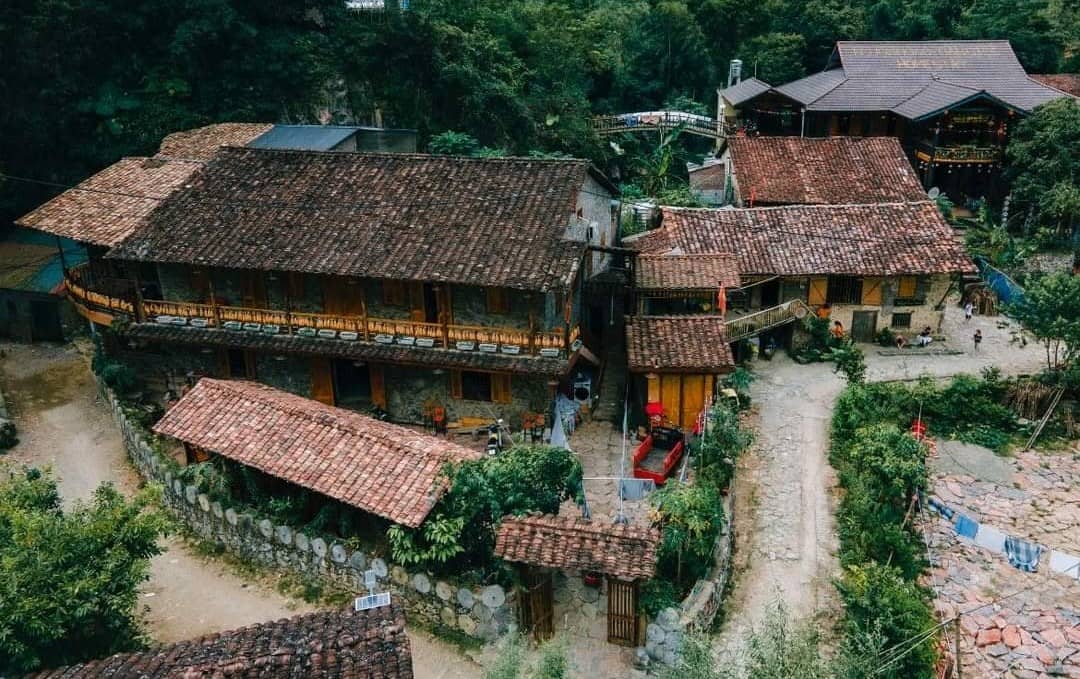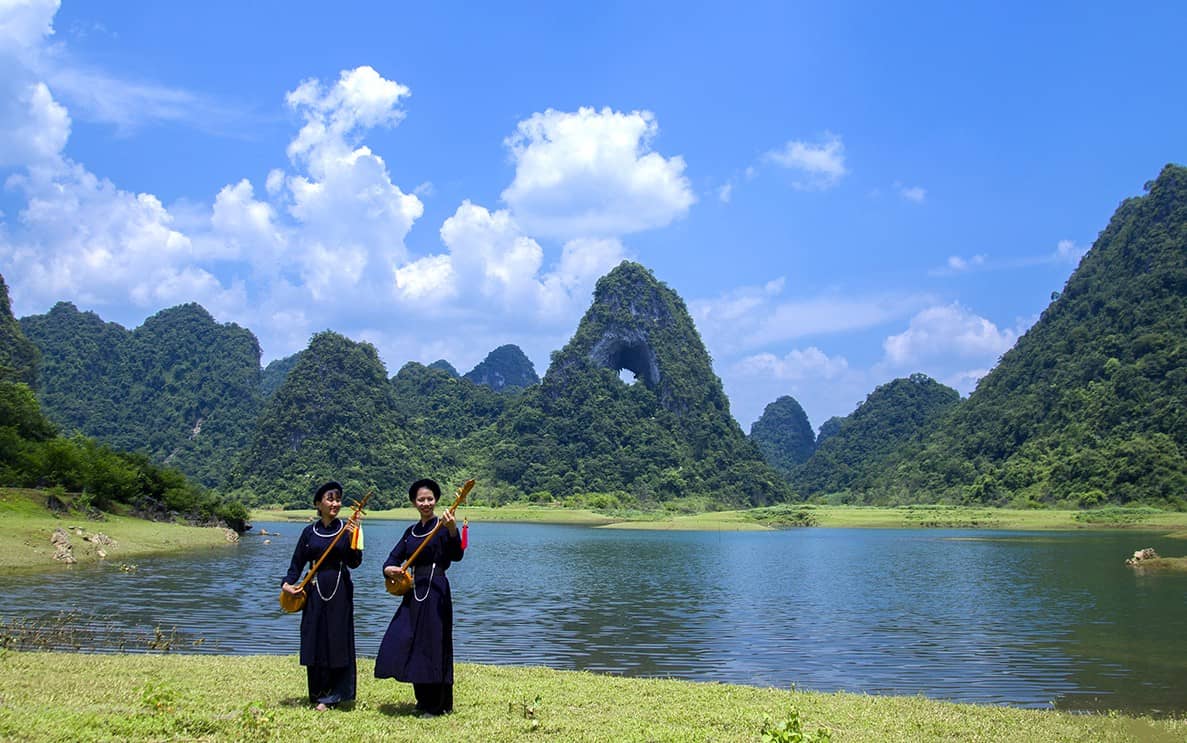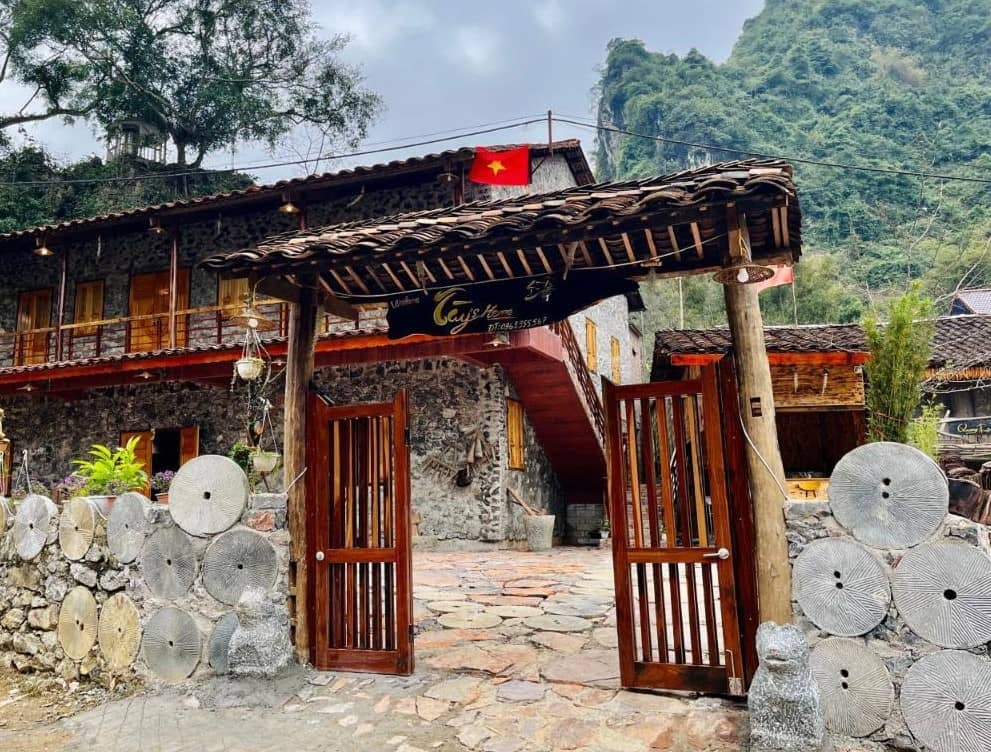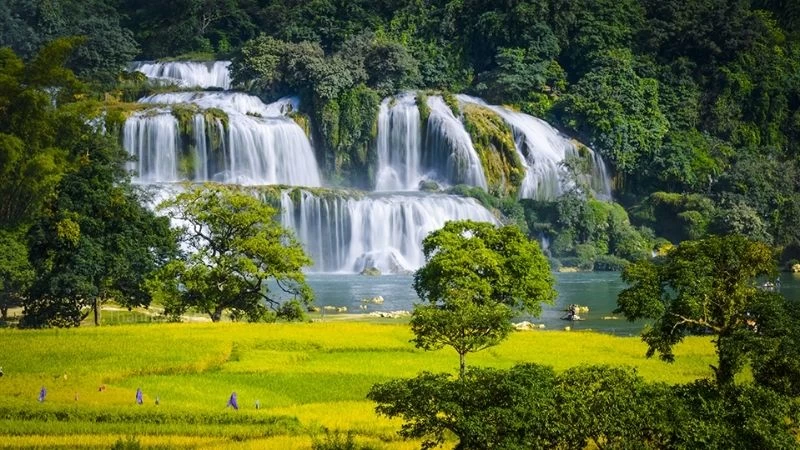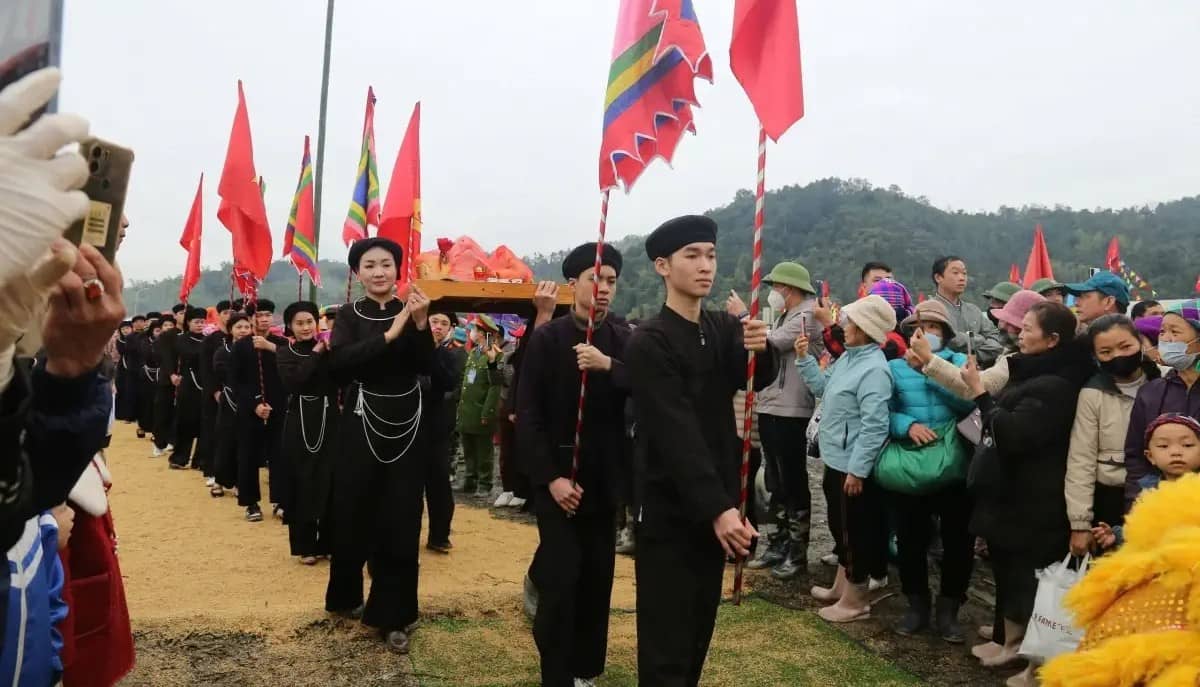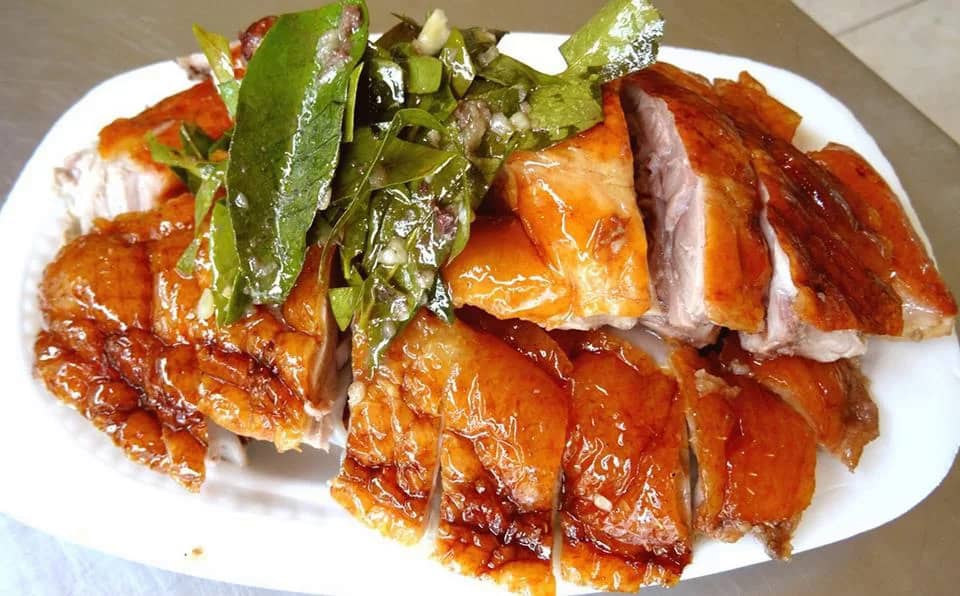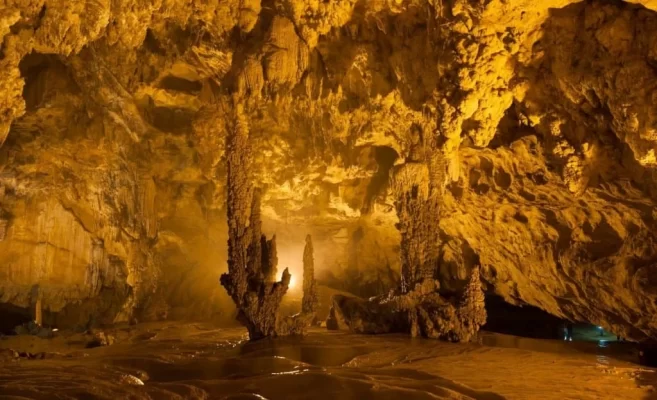
Let’s explore the most beautiful cave in Cao Bang!
Discover the breathtaking beauty of Nguom Ngao Cave in Cao Bang, Vietnam. Nestled near the stunning Ban Gioc Waterfall, this expansive limestone cave amazes visitors with its unique stalactites, grand caverns, and ancient legends. Explore hidden chambers, learn local folklore, and enjoy a natural wonder that captures the spirit of northern Vietnam’s rugged landscapes. Plan your adventure with Ula Travel to one of Vietnam’s must-visit destinations, ideal for nature lovers and explorers alike.
I. Introduction to Nguom Ngao Cave
1. Overview of Nguom Ngao Cave
Nguom Ngao Cave, an extraordinary natural wonder located in the northern Vietnamese province of Cao Bang, is just a short distance from the iconic Ban Gioc Waterfall. Nestled amid lush landscapes and limestone peaks, this cave has become a remarkable destination for those eager to explore Vietnam’s untouched natural beauty. Known for its stunning formations and unique charm, Nguom Ngao offers visitors an unforgettable underground journey.
2. The Meaning Behind the Name “Nguom Ngao”
The name “Nguom Ngao” comes from the Tay language, which is spoken by local ethnic communities in the area. Translating to “Tiger Cave” or “Roaring Cave,” the name hints at the mysterious atmosphere within.
Legend has it that the cave’s deep, resonant sounds resemble the growls of tigers or roars echoing through the limestone chambers. This captivating name has sparked curiosity among adventurers and added to the mystical allure surrounding Nguom Ngao Cave.
3. What Makes Nguom Ngao Cave Unique?
Nguom Ngao Cave spans an impressive length of approximately 2,144 meters (about 1.3 miles), with an intricate network of passageways and spacious chambers. Carved by natural forces over millions of years, the cave is adorned with magnificent stalactites and stalagmites, some resembling animals, mythical creatures, and other shapes that ignite the imagination. Its immense scale and pristine beauty set it apart, drawing nature enthusiasts and photographers alike.
II. How to Get to Nguom Ngao Cave
1. Traveling from Hanoi to Cao Bang
To begin your journey to Nguom Ngao Cave, you’ll first need to reach Cao Bang Province, located in northern Vietnam, approximately 280 kilometers from Hanoi. There are multiple transportation options available to suit different travel styles:
- By Bus: Taking an intercity bus from Hanoi to Cao Bang is a popular and affordable choice. Buses leave frequently from major terminals like My Dinh Bus Station in Hanoi, with journey times around 6-8 hours depending on traffic and road conditions.
- By Private Car or Taxi: For those seeking a faster and more convenient option, hiring a private car or taxi provides a comfortable and flexible ride to Cao Bang. The drive typically takes around 5-6 hours, allowing travelers to stop along the way at scenic viewpoints or local eateries.
- By Motorbike: Adventurous travelers may consider renting a motorbike, which allows for a more immersive experience through northern Vietnam’s mountainous landscapes. While this mode offers greater freedom and the chance to explore scenic detours, it requires careful planning, as the journey can be challenging due to winding roads.
2. From Cao Bang Center to Nguom Ngao Cave
Once you’ve arrived in Cao Bang City, Nguom Ngao Cave is within easy reach, situated roughly 85 kilometers northeast. The best route is to head to Trung Khanh Town, a small but bustling town close to the cave, offering a glimpse of local life and rural scenery.
From Cao Bang City, travelers can take a local bus or hire a motorbike, taxi, or car for a 2-hour journey through scenic mountain roads. This route is popular with visitors and locals alike due to its picturesque views and the chance to see small ethnic villages along the way.
III. Discovering the Inner Beauty of Nguom Ngao Cave
1. Intricate Internal Structure
Nguom Ngao Cave, stretching across nearly 2,144 meters, reveals a labyrinthine network of stunning formations, each a masterpiece of nature’s geological artistry. This captivating underground landscape includes several notable sections, each with unique stalactite and stalagmite formations that have taken thousands of years to create.
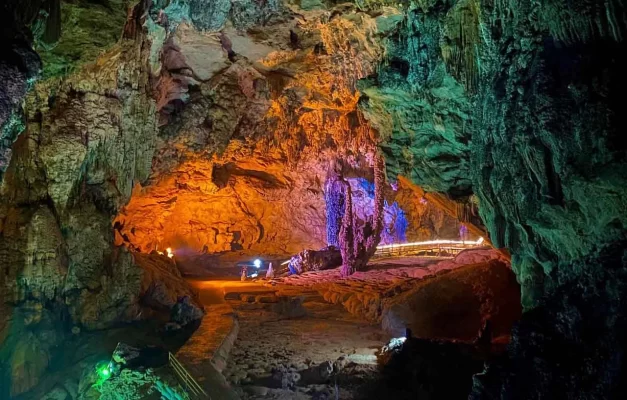
Inside Nguom Ngao Cave is an overwhelming scene.
Each chamber presents a distinct environment, showcasing diverse shapes and sizes sculpted by mineral-rich water dripping down from the cave’s ceiling, leaving trails of limestone in artistic designs. These mineral deposits have formed an awe-inspiring collection of natural columns, thin curtains, and otherworldly shapes that fill the cave.
Learn more about: Ha Giang to Cao Bang Tour
2. Distinctive Highlights Inside the Cave
Among the highlights of Nguom Ngao Cave, a few natural structures stand out for their beauty and grandeur. One such feature is the “Ivory Pillar”—a towering white column of calcite that gleams softly under the cave lights, resembling a magnificent tusk of ivory. There are also multiple chambers filled with glistening stalactites and stalagmites, resembling an ancient forest of stone, each element polished by water and time.
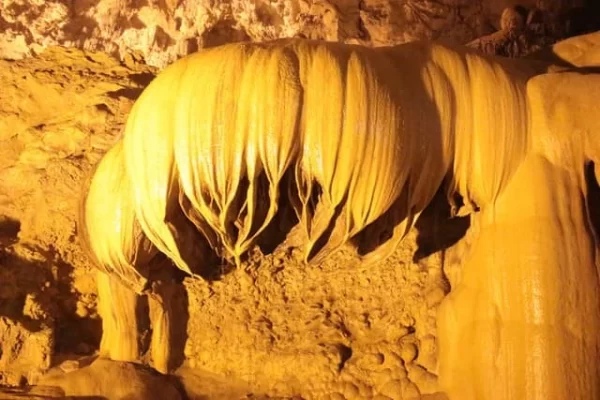
Majestic stalactites inside Nguom Ngao Cave.
Certain areas mimic cascading waterfalls, though made entirely of rock, while other formations resemble vast fields and towering cliffs, creating a landscape so surreal it appears almost like a stone jungle. Such features provide an ethereal and enchanting ambiance, giving travelers a rare glimpse into the powerful forces of nature at work below the Earth’s surface.
3. Local Legends and Stories
Nguom Ngao Cave is rich with local legends that add a layer of mystique to the experience. The Tày people, an ethnic minority in northern Vietnam, believe that the cave was once the dwelling of ancient tigers, hence its name, which translates to “Tiger Cave” or “Cave of the Roaring.”
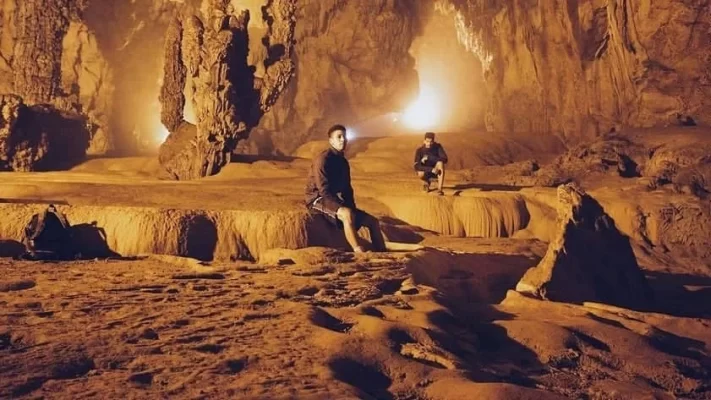
According to legend, Nguom Ngao Cave is home to tigers.
According to legend, the powerful roars of these mythical tigers could be heard echoing from within, striking awe and reverence in those nearby. There’s also a belief that the cave holds secrets and ancient spirits, guarding it through the ages. For international visitors, these stories not only add a deeper understanding of the cave’s cultural significance but also enrich the journey with a sense of wonder and respect for local traditions.
Read more: Discover Top 7 Things to Do in Cao Bang
IV. Must-Try Experiences at Nguom Ngao Cave
1. Capture Stunning Cave Formations
Nguom Ngao Cave offers a visual feast for photography enthusiasts, thanks to its extraordinary limestone formations and otherworldly ambiance. Inside the cave, visitors can capture unique shots of the magnificent stalactites and stalagmites, often shaped by natural forces into intricate patterns.
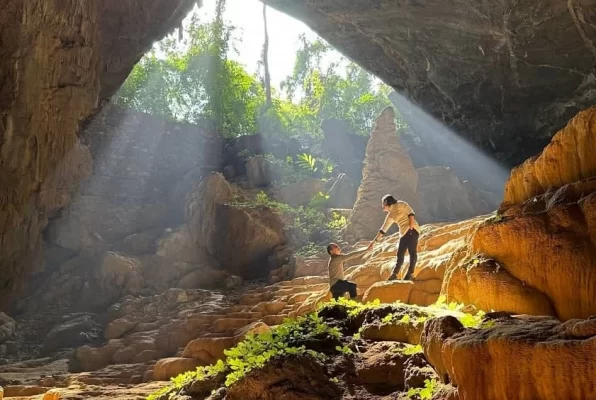
Don’t forget to bring your camera to capture the beautiful scenery inside the cave.
Certain areas within the cave are known for their particularly photogenic qualities, where light filters through openings, casting shadows that create an ethereal atmosphere. Be sure to explore the cave’s “Elephant’s Foot” formations and glistening mineral deposits—ideal backdrops for memorable travel photos. Travelers should bring cameras with wide-angle lenses or smartphones with night mode to fully capture these scenes, as flash photography may not always reveal the finer details.
2. Gain Insight from Local Experts
For those interested in a deeper understanding of Nguom Ngao Cave’s formation, history, and geological significance, guided tours are highly recommended. Local guides possess a wealth of knowledge about the cave’s background, including its origins, unique features, and the cultural legends that surround it.
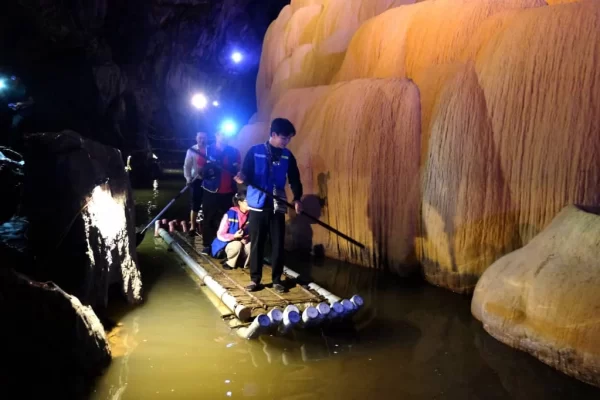
You should go with a local guide to ensure safety and the best experience.
They can lead visitors to hidden spots within the cave that casual explorers might overlook, enriching the tour with fascinating stories and insights into how these formations came to be. Opting for a guided tour also adds a level of safety and ease, as the cave’s terrain can be challenging to navigate without guidance. Many tour guides also speak English, which can enhance the experience for international visitors.
3. Tailor Your Experience
Exploring Nguom Ngao Cave can be a flexible experience, with options to tour independently or as part of a group. Independent exploration allows visitors to set their own pace, focusing on the areas they find most interesting, making it ideal for photographers, adventurers, or those looking for a quieter experience.
However, group tours offer camaraderie and shared excitement as fellow travelers discover the cave’s highlights together. Group tours are often led by knowledgeable guides who can point out the most remarkable formations and share stories, making them a perfect option for social travelers or families. Both options promise an unforgettable experience, allowing visitors to choose what best suits their travel style and level of adventure.
V. Essential Tips for Visiting Nguom Ngao Cave
1. Best Time to Visit Nguom Ngao Cave
Nguom Ngao Cave is open to visitors year-round, but the ideal months for exploration are typically from May to September. During this period, the weather is warmer, and natural light illuminates parts of the cave, adding to the stunning ambiance. This is also a time when the interior of the cave remains relatively dry, making it more accessible and comfortable to explore.
2. Weather Conditions
Nguom Ngao Cave is located in a region that experiences a tropical monsoon climate. The rainy season (usually from June to August) can bring heavy downpours, making parts of the cave slippery and difficult to navigate. Travelers are encouraged to plan their visits during the dry season, as rain may limit access to certain sections of the cave and affect overall visibility.
3. Recommended Clothing and Footwear
Given the cave’s rocky terrain and occasionally slippery surfaces, visitors should wear comfortable clothing and sturdy, non-slip footwear like hiking boots or quality sneakers. This type of attire will not only ensure a safer experience but also make it easier to climb and explore the cave’s many formations.
4. Safety Considerations
The interior of Nguom Ngao Cave can be dimly lit in certain areas, and some paths are uneven or narrow. For enhanced visibility and safety, consider bringing a personal flashlight or headlamp. Though the cave may provide some lighting, having your own source will improve visibility, especially when examining intricate rock formations or navigating low-light sections.
VI. Recommended Nearby Attractions Around Nguom Ngao Cave
1. Ban Gioc Waterfall
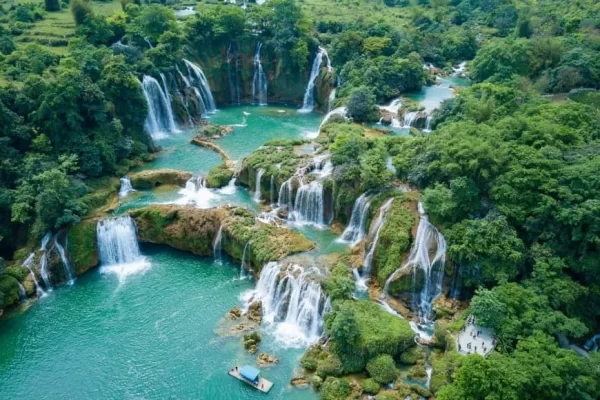
Ban Gioc Waterfall
Located approximately 3 kilometers from Nguom Ngao Cave, Ban Gioc Waterfall is one of the most stunning natural landmarks in Vietnam. Known as one of the largest waterfalls in Asia, Ban Gioc features multiple cascading tiers and stretches across the Vietnam-China border, creating a breathtaking landscape of mist, rushing water, and lush green surroundings.
A visit to Ban Gioc can be perfectly combined with Nguom Ngao Cave, allowing visitors to experience both underground and open-air natural wonders in a single day. The best times to see the falls in their full glory are during the rainy season from May to September, when the water flow is strongest.
Start your journey with: Hanoi to Ban Gioc Waterfall
2. Phat Tich Truc Lam Ban Gioc Pagoda
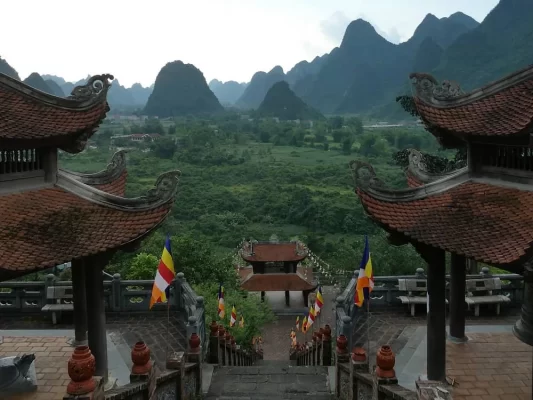
Phat Tich Truc Lam Ban Gioc Pagoda
For those interested in exploring local culture and spirituality, the Phat Tich Truc Lam Ban Gioc Pagoda is a must-visit destination near Ban Gioc Waterfall. This peaceful Buddhist pagoda, situated on a hilltop overlooking the waterfall, offers a unique blend of Vietnamese architecture and serene religious ambiance.
The pagoda serves not only as a place of worship but also as a site where visitors can learn about the teachings of Buddhism, enjoy panoramic views of the surrounding valleys, and experience a peaceful retreat. Visitors are encouraged to dress modestly and respectfully, as this is an active place of worship for locals and monks alike.
You might be like: Hanoi to Cao Bang Tour 3D2N
3. Traditional Villages and Local Delicacies
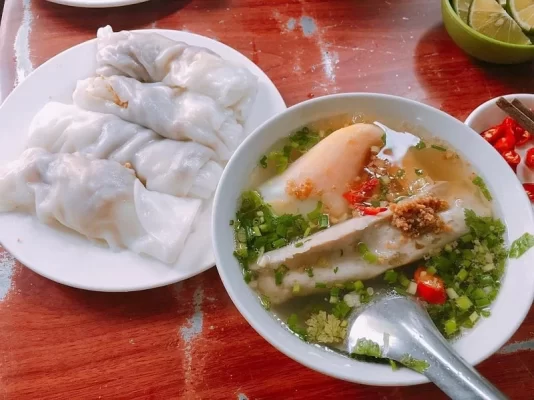
Steamed rice roll
Around Nguom Ngao Cave and Ban Gioc Waterfall, visitors can discover traditional craft villages that showcase the rich cultural heritage of the Tay, Nung, and other ethnic communities in Cao Bang. Here, artisans continue to practice ancient techniques, producing intricate textiles, bamboo crafts, and handmade pottery.
Additionally, the local markets offer unique specialties such as banh cuon Cao Bang (a steamed rice roll often paired with fresh herbs and broth), lap xuong (Cao Bang-style sausage), and roasted chestnuts. Sampling these delicacies provides an authentic taste of northern Vietnamese cuisine, and many items make perfect souvenirs.
Read more: Cao Bang Cuisine
VII. Suggested Itinerary for Visiting Nguom Ngao Cave
1. Morning: Start with Nguom Ngao Cave
Arrival at Nguom Ngao Cave (around 8:00 AM)
Begin your day early to enjoy a more peaceful experience inside the cave before it gets busier. Arriving around 8:00 AM allows you to witness the morning light filtering in, which highlights the cave’s intricate rock formations.
Exploring the Cave Interior (8:00 AM – 10:00 AM)
Nguom Ngao Cave is famous for its impressive stalactites and stalagmites, which resemble natural sculptures and mythical figures. A typical tour inside the cave lasts around 1.5 to 2 hours, where you can admire formations like the “Elephant’s Tusk” and shimmering “Silver Falls” area. Many visitors recommend bringing a flashlight for enhanced visibility and to observe details that might not be seen with standard cave lighting.
2. Midday: Visit Ban Gioc Waterfall (10:30 AM – 12:30 PM)
Short Trip to Ban Gioc Waterfall
After the cave exploration, head to Ban Gioc Waterfall, located just 3 km from Nguom Ngao Cave. Ban Gioc is one of the most stunning waterfalls in Asia, set on the Vietnam-China border and known for its impressive multi-tiered cascades.
Lunch in a Local Restaurant (12:30 PM – 1:30 PM)
After a morning of sightseeing, stop by a local restaurant nearby to try some regional dishes. Cao Bang offers delicious specialties like smoked buffalo meat and Steamed rice rolls, which showcase the unique flavors of northern Vietnamese cuisine.
3. Afternoon: Cultural Exploration and Relaxation
Visit Phat Tich Truc Lam Ban Gioc Pagoda (1:30 PM – 2:30 PM)
After lunch, make your way to the Truc Lam Ban Gioc Pagoda, located on a hill overlooking Ban Gioc Waterfall. The pagoda offers a peaceful setting for reflection and a beautiful panoramic view of the waterfall and surrounding valley. This is also a great opportunity to experience Vietnam’s Buddhist heritage in a serene natural environment.
Explore Local Villages (2:30 PM – 4:00 PM)
If time allows, take a detour to nearby villages to get a glimpse of local life and traditional crafts. Many of the Tày and Nùng ethnic communities in this area are known for their vibrant culture and hospitality. Visitors often enjoy visiting local handicraft workshops, where artisans create items like handwoven textiles, bamboo products, and pottery.
4. Late Afternoon: Return or Additional Sightseeing
Return to Cao Bang City (4:00 PM)
By late afternoon, you can begin your journey back to Cao Bang City, which is about a 1.5-hour drive from Nguom Ngao Cave. This allows you time to relax after a day of exploration and return comfortably before evening.
In conclusion, Nguom Ngao Cave offers travelers a rare chance to uncover the hidden beauty of Vietnam’s northern highlands, surrounded by breathtaking natural formations and fascinating legends. Its intricate stalactites, rich cultural tales, and awe-inspiring landscapes provide an unforgettable experience for visitors. Whether exploring solo or as part of a guided tour, a visit to Nguom Ngao Cave, paired with nearby attractions like the Ban Gioc Waterfall, promises a journey filled with wonder and discovery. This remarkable destination not only showcases the natural heritage of Cao Bang but also immerses you in a unique side of Vietnam that remains untouched by time.
See more: Cao Bang Travel Tips



